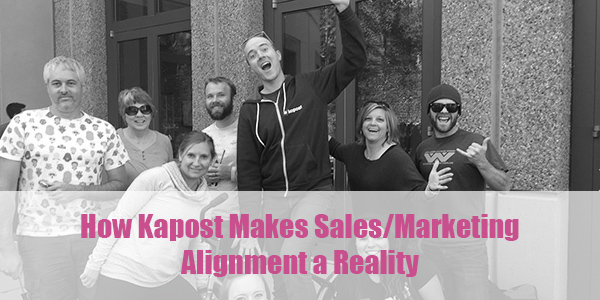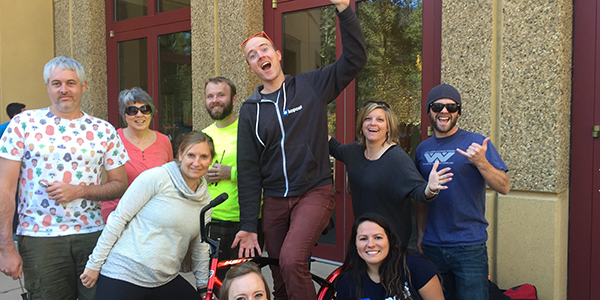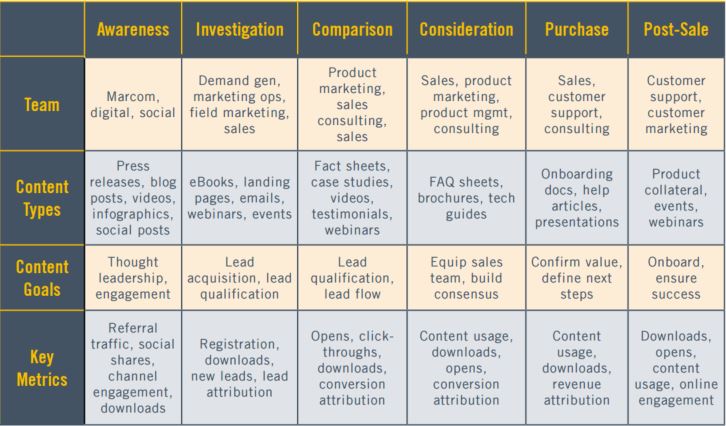
I’ve been a marketing professional for over 20 years, and everywhere I go—regardless of company size or product—I see the tell-tale tension between sales and marketing.
Sales is frustrated with marketing because they feel marketing continuously forces irrelevant content and messaging down their throats, even when they offer feedback. Likewise, marketing often finds sales impossible to please and resistant to absorb new messaging. It reminds me of classic sibling rivalry: you both know that the other is important, but ongoing frustration and power struggles persist because neither feels understood or respected.
At Kapost, both TEAM and INTERACTION are two of our five core values, so the concept of alignment has always been a part of our corporate culture. In fact, not a day goes by when I don’t hear someone on our team shout “#alignment!” (yes, with the hashtag) when they have experienced a cross-functional syncing of ideas or process with another Kaposter outside of their core team.
But actually making alignment a reality between these two departments takes much more than a monthly meeting and email notifications. We’ve learned from mistakes, tried things that have failed, and iterated over and over to make sure we’re all on the same page. Despite the bumps, bruises, and triumphs along the way, Kapost is committed to making sales/marketing alignment a reality—and lived to tell the tale.
In the spirit of Kapost’s commitment to sharing our experience and best practices with other marketers—be it the good, bad, or the ugly—we want to be transparent so that better sales/marketing alignment doesn’t happen just within our own hallways, but throughout the B2B industry.
Here are some of the key approaches we take:

1. We Align at the Human Level, Not Just the Process Level
At Kapost, we believe that first and foremost, we are people helping people—both customers and our colleagues. We are not robots and refuse to treat each other as such.
So to us, sales/marketing alignment means knitting people together at a human level, not just at the process level. It’s not about the database integration, setting up more meetings, or even the core messaging. It’s about cultivating a culture of people helping one another to be successful, as a community of Kaposters.
Sales/marketing alignment means knitting people together at a human level, not just at the process level.
So when we put this into the context of sales/marketing alignment, we think of it as a human-to-human activity rather than a tactical or strategic venture. When leadership takes this approach seriously, then the rest of your team begins to also embody this value. Inevitably, the approach will naturally shift from sales and marketing blaming one another to that of empowering one another—and we take this very seriously.
However, Kapost has doubled in size within the last 12 months, so alignment has quickly become even more of a challenge.
To cultivate this human-to-human attitude for sales and marketing, the head of sales and I have launched a new program of quarterly sales and marketing get-togethers. These aren’t brainstorming sessions or strategy discussions—they are planned solely as good old-fashioned hang outs to laugh and get to know each other—as humans and as teammates. Sales and marketing are both challenging crafts, deserving of respect. So when we allow our marketers and salespeople the space to get to know each other personally, it’s so much easier to recognize and respect the craft of the other. Because at the end of the day, marketing and sales truly are a team—regardless of the level of dysfunction.

2. Sales and Marketing Both Hold Quotas, So Both Teams Are Equally Accountable
At Kapost, both sales and marketing are responsible for meeting specific pipeline quota. These quotas are based on larger corporate objectives, and as a growing company, our team has to pivot frequently to meet these shifting objectives. Therefore, our marketing and sales team must become even more tightly aligned so that our process for hand-offs and lead nurturing is seamless and consistent.
Our marketing team is responsible for holding quota until opportunity two stage; this is far beyond the stage typically owned by marketing, which most often ends at marketing qualified lead stages (MQL). This is equal parts empowering and nerve-wracking for our marketing team. It means that we must create an exceptional buyer experience far beyond just a gated asset that then gets tossed over the fence to sales. By the time we hand off a lead to sales, we are responsible for ensuring that the lead aligns with our ideal customer profile.
When sales/marketing alignment is a human-to-human activity, not a tactical or strategic venture…it shifts from blame to empowerment.
This requires careful and strategic integration of our content flows and information hand-offs between marketing and our marketing development reps. On a tactical level, we had to rework our workflow strategy in Kapost to ensure the right players had visibility into the process. But even more importantly, to accomplish a smooth buyer experience, we needed to ensure that marketing and sales both had a deep understanding of each other’s roles.
So in Kapost’s human-centric spirit, we set up the “buddy” system. Marketers on my team are paired with sales reps and asked to regularly schedule days to shadow the other in their role. By pairing marketers with reps who are the first touch for potential leads, we deepen our understanding of how a lead transitions from self-directed online research, to speaking with a human for the first time.
Ultimately, this buddy system leads to empowering potential customers to learn more of what they need to know to solve their problems, faster—without the fluff.
3. We Prioritize Serving Content in Every Channel, at Every Stage
I discussed the prioritization of marketing content vs. content marketing in my last post, but I want to really emphasize the importance of this as it relates to our evolving marketing efforts here at Kapost.
Our team has grown from a primarily top-of-funnel focused content team, to a full-service marketing team, complete with not only a content team, but also product marketing, demand generation, and customer success marketing teams. This shift inevitably impacted the way our team thought about and did content. Now that we were a full-service team, we knew that marketing content couldn’t just be something used for generating traffic and MQLs—it must fuel every step of the buyer’s journey—from first engagement to closed deal to renewed customer.
The chart below depicts the types of marketing content we create at each stage of the buyer’s journey, and the teams associated with producing that content. As you can see, this can’t just fall on a content team—it takes a full-service marketing approach to deliver the right content, at the right team, to the right player in the purchase process.

But Christine, how do you stay aligned in your messaging and prevent silos?
This is where our content team plays a HUGE role. Our content team still produces top-of-funnel content like eBooks and blog posts, but they are also the editorial gatekeeper of every piece of content that is approved. We assigned specific content marketers to be the go-to editors for customer success marketing content, sales enablement content, video content, and so on. This way, we ensure a consistent voice across our buyer’s journey, and our content team has their hands in every stage. So when something gets misaligned, their team can hand raise and address it quickly. We use Kapost to provide visibility and drive workflows that support this tightly integrated marketing work.
We’re also amping-up communications with sales and customer success on marketing plans. With bigger teams and new people, we knew we needed to spend more time ensuring cross-team collaboration. We drink our own champagne and publish customer-facing and internal-only content to the Kapost Content Gallery. We track what gets shared and used, and we use that increased visibility of content usage to drive discussions with sales on next steps. We also supplement use of Kapost with internal marketing communications, including designated liaisons to sales and customer success teams, and we engage in internal marketing, including social and email newsletters to each customer-facing team as a weekly habit. We’re committed to #alignment and making it better every day.
Of course, alignment will always be a challenge requiring constant iteration. But our team is confident that as the Kapost product helps our team align and get visibility across marketing functions and customer-facing teams, that our journey and user story can help other B2B marketers discover new best practices as well.
